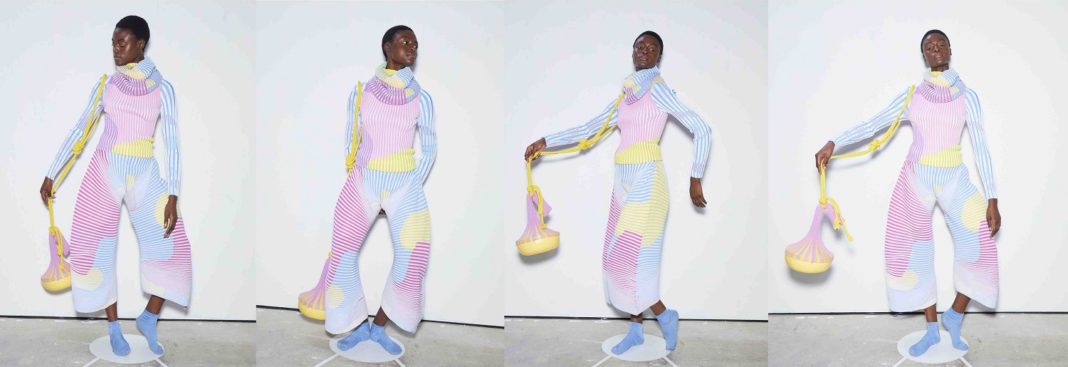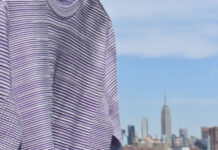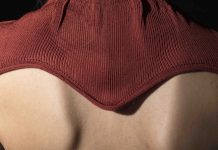Saturated with colour and enveloping the female form in sculptural silhouettes, Yu-mei Huang’s distinctive MA Collection combines playful approaches to design with logical methods of garment engineering. Featured during her Work in Progress Show on Knitting Industry Creative in February 2019, we caught up with Yu-mei to learn the inspiration and process behind her MA Graduate Collection and discover how she has refined her process to present her body of work this summer.
With a BA in Knitwear Design from Fu Jen Catholic University in Taiwan, Yu-mei came to London to study her two year MA in Fashion Knitwear at The Royal College of Art. It was here that her textile-based approach to garment design became defined by her unique aesthetic.

Choosing the creative hub of the RCA was an obvious decision for Yu-mei, as it is widely recognised as one of the best Fashion Design courses in the world. Unlike some MA courses, the RCA also offers the opportunity to study for two years, which allows for thorough and intense exploration of one’s specialism.
When discussing with Yu-mei what kind of designer she is, it was interesting to hear how she approaches fashion and garment design as not only an opportunity to dress the human body, but as a way to impact the psychology of the wearer. The interacting of wearers with her designs is of great interest to her and understanding how people connect with the clothes she knits influences her design process.
Giving an insight into her style of creative process, Yu-mei shared: “I feel like I’m more like a textile person as well as a fashion designer. I design fabrics and I design garments all at once. As soon as I build up my concept, I always start from the material choice (yarn) and then think about the colour, quality, weight. Once I have made these decisions, I go to the knitting machines”. She went on: “It’s important for me to work and think when I’m knitting. Through knitting samples with different techniques and experimenting with a variety of colourways, I start building an archive of project specific fabric samples. I then take these fabrics to mannequins, drape them on the stand and see what can work together”.

In terms of recording her methods and process, Yu-mei explained: “Documenting processes through photography, I often work digitally to edit and manipulate my images to see different potential outcomes. It’s quite handy for me to play with the proportion in Photoshop, then print ideas out to scale so I can begin to sketch with a true perspective of scale. This development from textiles to garment is the main focus in my design process, which is also the part I found most interesting.”
A Therapeutic Space: Let the materials lead the shape
In her MA Graduate Collection, Yu-mei focussed on integrating a new approach between fashion and psychology to create a therapeutic space for the body. In her development, it was important that materials could contribute to therapeutic feelings which could then trigger a sense of comfort in the wearer. By focussing on the relationship between garment and wearer, the silhouette shifted and changed as each new wearer dressed in it, and Yu-mei found this fascinating. She felt she was creating a multi-sensory space within her garments that could influence mood and human emotion.
Yu-mei’s approach to sustainable design is as focussed on psychology as functionality. She explained: “To me, sustainable fashion is not only about recycling materials but also about bringing more personality into the garments and building a relationship between the garment and the wearer.”
With this sentiment in mind, Yu-mei experimented with material choices that could expand, allowing for adaptation to a variety of body types in a bid to combat the current, often wildly inaccurate sizing system. This is an intriguing concept. It is certainly the case that as buyers, choosing which sizes of what lines to stock can lead to waste if the wrong quantities are purchased and manufactured.

Knitted fabrics lend themselves by nature to stretching and compressing, flexing and forming. Perhaps this inherent ability of knit to adapt so neatly could be a catalyst for sizing change. Not only this, but on a psychological level, the benefits of not categorising each person based on the size of their waistline could be a positive change, pushing the current sizing and labelling system to become less rigid an encourage body positivity. Yu-mei’s suggestion that if garments were to be more universally sized this could tackle the current waste system is therefore an interesting one.
How did the collection progress after the WIP Show?
Reflecting on her personal development since the RCA WIP show in February, Yu-mei explained that earlier in the year, her design process was focussed on concept development and material experimentation. Since her presentation at the show, she moved her focus to seeing how the materials she had been working on could interact with the human form, and how she could achieve wearable art.
Utilising yarns from industry spinners Be.mi.va, Sesia, and Flipucci amongst others, Yu-mei’s garments combined cellulose and petrochemical based fibres. This allowed for a soft, luxurious handle combined with stretch and durability, so wearers would become enveloped in luxury whilst able to react and stretch within her garments.

For Yu-mei, it was important to start from material and hold that as the origin. The process of selecting yarns, exploring textures, spin and quality followed with developing shades and colours, leading to sample development. Speaking of her fascination with the ability of yarn choice to ultimately dictate silhouette, Yu-mei explained: “It is interesting to see how the material leads the silhouette, and the finishing of the trims and details.”
The natural inclinations of yarns can often only be discovered upon applying them to a certain knitted structure, so the sampling process allowed Yu-mei to experiment with informed choices and explore unexpected outcomes.
Fabric development for Yu-mei saw the creation of intarsias, jacquards, dubied and flatbed knits as well as Stoll and Shima Seiki development. Trialling tubular structures, ribs, drop stitches and mock ribs, Yu-mei experimented with analogue and digital knitting techniques. Even introducing experimentation on her domestic knitting machine, she trialled partial knitting, intarsia and e-wrap techniques, showcasing her strong capabilities across a breadth of knitting methods.
Inspired by the works of artists, such as Ernesto Neto, Erwin Wurm and Hans Hemmert, Yu-mei also admires the work of Issey Miyake’s sculptural garments and forms. Their influence on her creative style is clear to see, particularly in her approach to the presentation of her work through her beguiling imagery.

The future certainly appears to be bright for Yu-mei, as she has been sponsored to join London Fashion Week with Fashion Scout this September. At LFW, she will present her collection to industry and the media, and hopefully gain funding for further development.
Hoping to gain experience within high fashion brands, Yu-mei aspires to one day open her own design studio and become creative director of her own brand. Seeing another knitwear designer be taken on by Fashion Scout is such a positive endorsement for knitwear students and a testament to the RCA Fashion Course, and Yu-mei’s chance to showcase her work is certainly an event to look forward to this Autumn.
Further reading
Work In Progress: Yu-Mei Huang
FJU Talents is an annual platform showcasing emerging designers from Taiwan

Subscribe To Our Newsletter
Join our mailing list to receive the latest news and updates from our team.














